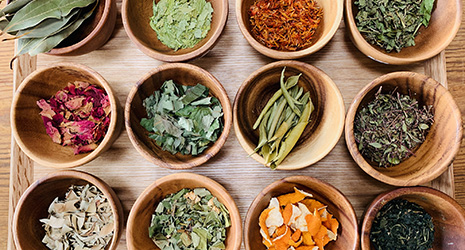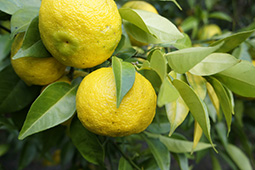April 2020
The Blessings of Wa-Herb

In Japan, the plants collectively referred to as wa-herb are used to add flavor to food and support people’s lives in many different situations.
People in some regions such as Europe and Southeast Asia have a long-nurtured culture of using herbs, such as mint, rosemary, parsley and coriander, to add aroma to food and for aromatherapy. Japanese people too have a long history of using herbs and spices. In Japanese cuisine, shiso (perilla), sansho (pepper) and ginger are commonly used, while mitsuba (Japanese chervil) and wasabi (Japanese horseradish), unique to Japan, are two more examples. As in Europe, mint (hakka), parsley (shaku) and elderflower (niwatoko) have also long been used.

The Japan Herb Federation defines wa-herb (“wa” means Japanese) as the useful plants that have grown naturally or been cultivated in many parts of Japan since before the Edo period (1603–1867). According to Furuya Masaki, director of the federation, the appeals of wa-herb are not limited to their use in meals. “Geographically, the Japanese archipelago is long north-south and has wide differences in altitude. Vegetation is very diverse in Japan and our ancestors enjoyed the blessings of many plants. If you look at the traditional lifestyles of Japanese people, you can clearly see how plants have colorfully contributed to people’s clothing, food and housing.”
Fittings such as shoji in wooden Japanese-style houses involve the use of washi Japanese paper made from the fibers of kozo (paper mulberry) and mitsumata. Tatami is made from rushes with a superb ability to absorb and release moisture and also a wonderful scent. Rice straw, bamboo, the crimson glory vine and other species were used to make household goods such as baskets. Hemp fibers were used to weave cloth, which was dyed with plants creating an indigo called Japan blue, safflower, madder red, purple and other colors. Many of these pigments are considered to have antibacterial or insect-repelling effects.
“Japan has the world’s longest life expectancy. I believe the secret of its longevity is that people have long taken wa-herb grown in Japan as foods and medicines. Wa-herb contain many useful parts, and the entirety of the plants, including flowers, leaves, stems, roots, fruits and barks are used for many different purposes. The culture of using these herbs as ingredients has been nurtured in the areas where they have long grown and are examples of local wisdom. I believe we should revive and use this wisdom for the benefit of all Japanese people today,” says Furuya.
For example, there are traditional food cultures around the country which make good use of leaves as ingredients for wrapping foods. Examples include sushi rolled in persimmon or striped bamboo leaves, and sweet rice cakes rolled in cherry, oak, Japanese ginger or shell ginger leaves. These leaves help to preserve and add their scent to the food, enhancing its flavor. Wa-herb is also used in baths. The custom of floating seasonal herbs in bathtubs has taken root in households. For example, people put yuzu in baths on the winter solstice, as the fruit effectively stimulates blood circulation and warms the body. For Tango no Sekku on May 5, an annual ceremony to pray for the healthy growth of children, shobu (sweet flag) is placed into bathtubs as it has a pleasant aroma and is also said to be good for health.

Wa-herb has a long history of medicinal use. According to Furuya, Japan’s five major traditional medicines are Thunberg’s geranium (Geranium thunbergii), chameleon plant (Houttuynia cordata), Swertia (Swertia japonica), grand ivy (Glechoma hederacea) and angelica tree (Aralia elata), which have been used as gastrointestinal medicines and antidotes. Teas prepared with wormwood or loquat leaves are commonly used to relax the mind and body.


“Recently, people mix several types of wa-herb in the teas they drink. Wa-herb is mostly familiar plants but they are a treasure. If you adapt them to your lifestyle while learning from tradition, your everyday life will be enriched,” says Furuya.


